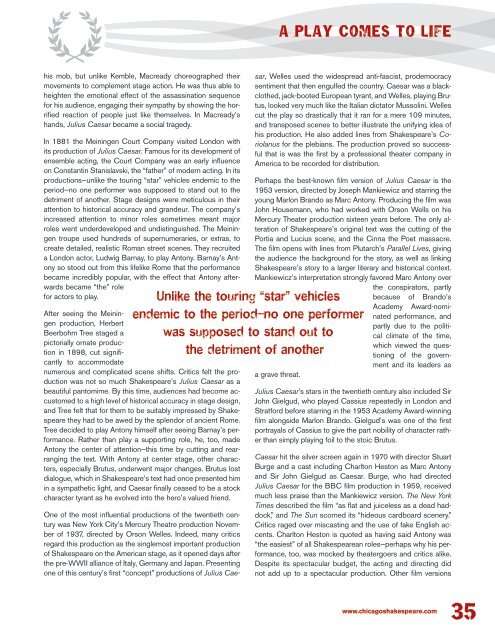Julius Caesar • 2013 - Chicago Shakespeare Theater
Julius Caesar • 2013 - Chicago Shakespeare Theater
Julius Caesar • 2013 - Chicago Shakespeare Theater
You also want an ePaper? Increase the reach of your titles
YUMPU automatically turns print PDFs into web optimized ePapers that Google loves.
his mob, but unlike Kemble, Macready choreographed their<br />
movements to complement stage action. He was thus able to<br />
heighten the emotional effect of the assassination sequence<br />
for his audience, engaging their sympathy by showing the horrified<br />
reaction of people just like themselves. In Macready’s<br />
hands, <strong>Julius</strong> <strong>Caesar</strong> became a social tragedy.<br />
In 1881 the Meiningen Court Company visited London with<br />
its production of <strong>Julius</strong> <strong>Caesar</strong>. Famous for its development of<br />
ensemble acting, the Court Company was an early influence<br />
on Constantin Stanislavski, the “father” of modern acting. In its<br />
productions—unlike the touring “star” vehicles endemic to the<br />
period—no one performer was supposed to stand out to the<br />
detriment of another. Stage designs were meticulous in their<br />
attention to historical accuracy and grandeur. The company’s<br />
increased attention to minor roles sometimes meant major<br />
roles went underdeveloped and undistinguished. The Meiningen<br />
troupe used hundreds of supernumeraries, or extras, to<br />
create detailed, realistic Roman street scenes. They recruited<br />
a London actor, Ludwig Barnay, to play Antony. Barnay’s Antony<br />
so stood out from this lifelike Rome that the performance<br />
became incredibly popular, with the effect that Antony afterwards<br />
became “the” role<br />
for actors to play.<br />
After seeing the Meiningen<br />
production, Herbert<br />
Beerbohm Tree staged a<br />
pictorially ornate production<br />
in 1898, cut significantly<br />
to accommodate<br />
numerous and complicated scene shifts. Critics felt the production<br />
was not so much <strong>Shakespeare</strong>’s <strong>Julius</strong> <strong>Caesar</strong> as a<br />
beautiful pantomime. By this time, audiences had become accustomed<br />
to a high level of historical accuracy in stage design,<br />
and Tree felt that for them to be suitably impressed by <strong>Shakespeare</strong><br />
they had to be awed by the splendor of ancient Rome.<br />
Tree decided to play Antony himself after seeing Barnay’s performance.<br />
Rather than play a supporting role, he, too, made<br />
Antony the center of attention—this time by cutting and rearranging<br />
the text. With Antony at center stage, other characters,<br />
especially Brutus, underwent major changes. Brutus lost<br />
dialogue, which in <strong>Shakespeare</strong>’s text had once presented him<br />
in a sympathetic light, and <strong>Caesar</strong> finally ceased to be a stock<br />
character tyrant as he evolved into the hero’s valued friend.<br />
One of the most influential productions of the twentieth century<br />
was New York City’s Mercury Theatre production November<br />
of 1937, directed by Orson Welles. Indeed, many critics<br />
regard this production as the singlemost important production<br />
of <strong>Shakespeare</strong> on the American stage, as it opened days after<br />
the pre-WWII alliance of Italy, Germany and Japan. Presenting<br />
one of this century’s first “concept” productions of <strong>Julius</strong> Cae-<br />
A PLAY COMES TO LIFE<br />
sar, Welles used the widespread anti-fascist, prodemocracy<br />
sentiment that then engulfed the country. <strong>Caesar</strong> was a blackclothed,<br />
jack-booted European tyrant, and Welles, playing Brutus,<br />
looked very much like the Italian dictator Mussolini. Welles<br />
cut the play so drastically that it ran for a mere 109 minutes,<br />
and transposed scenes to better illustrate the unifying idea of<br />
his production. He also added lines from <strong>Shakespeare</strong>’s Coriolanus<br />
for the plebians. The production proved so successful<br />
that is was the first by a professional theater company in<br />
America to be recorded for distribution.<br />
Perhaps the best-known film version of <strong>Julius</strong> <strong>Caesar</strong> is the<br />
1953 version, directed by Joseph Mankiewicz and starring the<br />
young Marlon Brando as Marc Antony. Producing the film was<br />
John Housemann, who had worked with Orson Wells on his<br />
Mercury <strong>Theater</strong> production sixteen years before. The only alteration<br />
of <strong>Shakespeare</strong>’s original text was the cutting of the<br />
Portia and Lucius scene, and the Cinna the Poet massacre.<br />
The film opens with lines from Plutarch’s Parallel Lives, giving<br />
the audience the background for the story, as well as linking<br />
<strong>Shakespeare</strong>’s story to a larger literary and historical context.<br />
Mankiewicz’s interpretation strongly favored Marc Antony over<br />
the conspirators, partly<br />
Unlike the touring “star” vehicles<br />
endemic to the period—no one performer<br />
was supposed to stand out to<br />
the detriment of another<br />
a grave threat.<br />
because of Brando’s<br />
Academy Award-nominated<br />
performance, and<br />
partly due to the political<br />
climate of the time,<br />
which viewed the questioning<br />
of the government<br />
and its leaders as<br />
<strong>Julius</strong> <strong>Caesar</strong>’s stars in the twentieth century also included Sir<br />
John Gielgud, who played Cassius repeatedly in London and<br />
Stratford before starring in the 1953 Academy Award-winning<br />
film alongside Marlon Brando. Gielgud’s was one of the first<br />
portrayals of Cassius to give the part nobility of character rather<br />
than simply playing foil to the stoic Brutus.<br />
<strong>Caesar</strong> hit the silver screen again in 1970 with director Stuart<br />
Burge and a cast including Charlton Heston as Marc Antony<br />
and Sir John Gielgud as <strong>Caesar</strong>. Burge, who had directed<br />
<strong>Julius</strong> <strong>Caesar</strong> for the BBC film production in 1959, received<br />
much less praise than the Mankiewicz version. The New York<br />
Times described the film “as flat and juiceless as a dead haddock,”<br />
and The Sun scorned its “hideous cardboard scenery.”<br />
Critics raged over miscasting and the use of fake English accents.<br />
Charlton Heston is quoted as having said Antony was<br />
“the easiest” of all <strong>Shakespeare</strong>an roles—perhaps why his performance,<br />
too, was mocked by theatergoers and critics alike.<br />
Despite its spectacular budget, the acting and directing did<br />
not add up to a spectacular production. Other film versions<br />
www chicagoshakespeare com 35




